
In Plain Sight: Jewish Arts and Lives in the Muslim World
Following the rise of Islam in the 7th century CE, Jewish communities developed under Muslim empires from North India to Spain. They constituted the largest Jewish population in the world until the Modern Era, waning with the decline of the Ottoman empire in the 20th century. Their heritage—spanning centuries, regions, and languages—retains traces of the Muslim world even after subsequent migrations to Israel, Europe, the Americas, and Australia.
The echoes of the Jewish-Muslim encounters are, in fact, at the core of today’s Jewish experience. They speak of human connections across divides, prompt reconsideration of assumptions that shape our public cultural and political debates, and map the precious possibilities (and inherent fragility) of coexistence, mutual appreciation, and belonging to many cultures at once.
In Plain Sight draws a selection from over 1,400 objects in the Magnes’s permanent collection originating in Muslim lands, organized to reflect cultural affinities and common threads. They highlight rootedness in diaspora, shared graphic forms and visual landscapes, attitudes towards sacred texts and human bodies, and networks of trade and knowledge exchange, all centering around the fundamental role of light in Jewish and Muslim prayer spaces. The juxtapositions create further associationsand narratives—through shapes, colors, materials, and techniques—that move across cultures and geographies.
This exhibition also represents the culmination of over five years of curatorial collaboration. As curators of Jewish and Islamic art, we examined objects together, studied primary sources ranging from visual culture to architecture and music, and read secondary literature in several languages—at times flanked by UC Berkeley students and scholars in various disciplines. We spent many hours in the fashion of the Talmudic chavruta: two students—with complementary, divergent, and contradicting views—training ourselves in the other’s perspective, seeing the same object with the other’s eyes, and forming, day after day, a shared perspective, a common sensibility.
What emerges here aims at making the familiar unfamiliar and fresh, at seeing what was unseen, and at engaging viewers in a path of discovery in which the whole is much greater than the sum of its parts.
~ Qamar Adamjee and Francesco Spagnolo
The Magnes: Collecting Beyond Borders
In the 1970s and 1980s, the Magnes (est. 1962) actively shaped its collections beyond the scope of most Jewish museums in the United States. The museum’s founders skirted a then-prevailing approach that centered the Jewish experience on European history, arts, and aesthetics, and on the Ashkenazi world. They instead organized self-directed “rescue missions”: expeditions aimed at collecting the cultural heritage of vanishing Jewish communities worldwide, with a focus on Muslim lands. While more and more Jews left their historic homelands—as refugees escaping persecution and as immigrants seeking better living conditions—the very objects that they had been forced to leave behind or sell were brought to Berkeley. Museum staff and volunteers traveled across North Africa (most notably to Morocco, Tunisia, and Egypt), the Eastern Mediterranean (Greece and Turkey), Central Asia (Bukhara), and India, and also acquired objects from families that had immigrated to the United States from Iraq and Iran. The inclusion of material culture from the Muslim world makes the Magnes Collection of Jewish Art and Life a prime representative of the cultures of the global Jewish diaspora.
Image at top: Ira Nowinski, Karaite synagogue, Cairo, Egypt, 1985. Gift of the artist. Magnes Collection of Jewish Art and Life, UC Berkeley, 85.49.8 © Ira Nowinski/Stanford Libraries.
Curator:
Francesco Spagnolo
Visiting Curator:
Qamar Adamjee
Undergraduate Curatorial Assistant (URAP):
Paris Grae Bailey
Registrar:
Julie Franklin
Assistant Registrar:
Andrea Calderon
Head Preparator:
David Sullivan
Preparator:
Jennifer Cole
Design:
Carole Jeung
Undergraduate Research Apprentices (URAP):
Abe Jellinek, Walker Laughlin, Kayla Cohen, Philopathear Iweda, Felix Rosen, Cynthia Rahman
In Plain Sight Exhibition Production Files
Related Programs & Events September 5, 2024 Exhibition Opening | In Plain Sight: Jewish Arts and Lives in the Muslim World
September 5, 2024 Exhibition Opening | In Plain Sight: Jewish Arts and Lives in the Muslim World
 September 6, 2024 Workshop | Curating In Plain Sight: Jewish Arts and Lives in the Muslim World
September 6, 2024 Workshop | Curating In Plain Sight: Jewish Arts and Lives in the Muslim World
 September 23, 2024 Victoria Hanna at In Plain Sight: Sounds Create Worlds
September 23, 2024 Victoria Hanna at In Plain Sight: Sounds Create Worlds
 December 5, 2024 Sacred Light: Conversation with Deena Aranoff and Mahjabeen Dhala
December 5, 2024 Sacred Light: Conversation with Deena Aranoff and Mahjabeen Dhala
 December 12, 2024 From Sanandaj to Essaouira: Journey through Modal Music
December 12, 2024 From Sanandaj to Essaouira: Journey through Modal Music
 February 3, 2025 Virtual | Our Own Stories: Authors on Jewish Life in the Muslim World
February 3, 2025 Virtual | Our Own Stories: Authors on Jewish Life in the Muslim World
 March 2, 2025 Teens Take the Magnes at “In Plain Sight”
March 2, 2025 Teens Take the Magnes at “In Plain Sight”
 March 6, 2025 Texts You Can Taste: Sephardic Culinary Heritage
March 6, 2025 Texts You Can Taste: Sephardic Culinary Heritage
 March 20, 2025 Henna Party: Celebrate Middle Eastern Jewish Wedding Traditions
March 20, 2025 Henna Party: Celebrate Middle Eastern Jewish Wedding Traditions
Magnes exhibit on Jewish lives in Muslim lands: ‘What the world needs right now’ | August 26, 2024 | J. The Jewish News of Northern California
In Plain Sight is generously supported by the Walter & Elise Haas Fund, David Berg Foundation, Kenneth Kofman and Andrea King, and an anonymous donor.
The curators wish to thank Karen Barkey, Emily Gottreich, and Ethan Katz (UC Berkeley); Noam Sienna (University of Toronto); Filiz Çakır Phillip (Aga Khan Museum); Deena Aranoff and Carole Bier (Graduate Theological Union).
Research for this exhibition project was made possible, in part, with assistance from UC Berkeley’s Undergraduate Research Apprentice Program (URAP).
Excerpts from Shemuel Aron Romanelli’s travelogue, Travail in an Arab Land (originally published in Hebrew in 1792, English translation by Yedida Kalfon Stillman and Norman A. Stillman, University of Alabama Press, 1989), appear throughout the exhibition. Musical selections include recordings from the National Sound Archives of the National Library of Israel and the Library of Congress.



